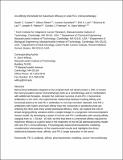| dc.contributor.author | Cowles, Sarah C. | |
| dc.contributor.author | Sheen, Allison | |
| dc.contributor.author | Santollani, Luciano | |
| dc.contributor.author | Lutz, Emi A. | |
| dc.contributor.author | Lax, Brianna M. | |
| dc.contributor.author | Palmeri, Joseph R. | |
| dc.contributor.author | Freeman, Gordon J. | |
| dc.contributor.author | Wittrup, K. Dane | |
| dc.date.accessioned | 2022-08-09T14:40:28Z | |
| dc.date.available | 2022-08-09T14:40:28Z | |
| dc.date.issued | 2022-08-04 | |
| dc.date.submitted | 2022-03-24 | |
| dc.identifier.issn | 1942-0862 | |
| dc.identifier.issn | 1942-0870 | |
| dc.identifier.uri | https://hdl.handle.net/1721.1/144276 | |
| dc.description.abstract | Monoclonal antibodies targeted to the programmed cell death protein 1 (PD-1) remain the most prevalent cancer immunotherapy both as a monotherapy and in combination with additional therapies. Despite the extensive success of anti-PD-1 monoclonal antibodies in the clinic, the experimental relationship between binding affinity and functional potency for anti-PD-1 antibodies in vivo has not been reported. Anti-PD-1 antibodies with higher and lower affinity than the nivolumab or pembrolizumab are entering the clinic and show varied preclinical efficacy. Here, we explore the role of broad-ranging affinity variation within a single lineage in a syngeneic immunocompetent mouse model. By developing a panel of murine anti-PD-1 antibodies with varying affinity (ranging from KD = 20 pM - 15 nM), we find that there is a threshold affinity required for maximum efficacy at a given dose in the treatment of the MC38 adenocarcinoma model with anti-PD-1 immunotherapy. Physiologically based pharmacokinetic modeling complements interpretation of the experimental results and highlights the direct relationship between dose, affinity, and PD-1 target saturation in the tumor. | en_US |
| dc.language.iso | en_US | |
| dc.publisher | Taylor & Francis | en_US |
| dc.relation.isversionof | 10.1080/19420862.2022.2088454 | en_US |
| dc.rights | Creative Commons Attribution-Noncommercial-Share Alike | en_US |
| dc.rights.uri | http://creativecommons.org/licenses/by-nc-sa/4.0/ | en_US |
| dc.source | Taylor & Francis | en_US |
| dc.title | An affinity threshold for maximum efficacy in anti-PD-1 immunotherapy | en_US |
| dc.type | Article | en_US |
| dc.identifier.citation | Cowles, Sarah C., Sheen, Allison, Santollani, Luciano, Lutz, Emi A., Lax, Brianna M. et al. 2022. "An affinity threshold for maximum efficacy in anti-PD-1 immunotherapy." mAbs, 14 (1). | |
| dc.contributor.department | Koch Institute for Integrative Cancer Research at MIT | |
| dc.contributor.department | Massachusetts Institute of Technology. Department of Chemical Engineering | |
| dc.contributor.department | Massachusetts Institute of Technology. Department of Biological Engineering | |
| dc.relation.journal | mAbs | en_US |
| dc.eprint.version | Author's final manuscript | en_US |
| dc.type.uri | http://purl.org/eprint/type/JournalArticle | en_US |
| eprint.status | http://purl.org/eprint/status/PeerReviewed | en_US |
| dspace.date.submission | 2022-06-24T13:33:04Z | |
| mit.journal.volume | 14 | en_US |
| mit.journal.issue | 1 | en_US |
| mit.license | OPEN_ACCESS_POLICY | |
| mit.metadata.status | Authority Work and Publication Information Needed | en_US |
